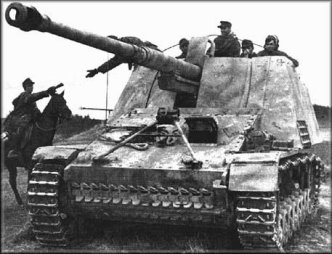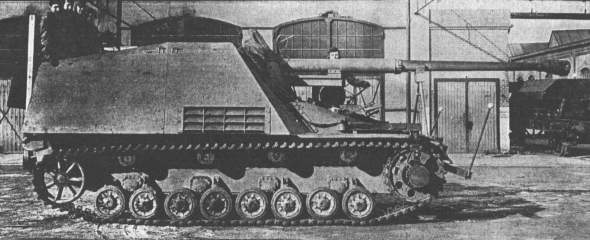|
|
|
Nashorn

German
Nashorn - Sd.Kfz. 164
In the opening months of operation Barbarosa, the German tankers were very unpleasantly surprised to discover that their PzKpfw III and IV were no match for the Russian T-34 and Kv heavy tanks. As a temporary solution of this problem, till better tanks were to be designed, it was decided to produce a heavy anti-tank gun carrier.
The new Panzerjager was to use either Panzer III's or Panzer IV's chassis, but since neither of them was suited to be an effective self-propelled mount, the idea of using them was finally rejected. Instead, a special chassis, newly developed by Alkett : the Geschutzwagen ( gun carriage ) III/IV, was used. It combined components of both PzKpfw III (mainly Ausf. J - engine, fuel pump, driving and steering mechanisms) and PzKpfw IV (mainly Ausf F - suspension). Because the Nashorn was to be equipped with an 88mm Pak 43 L/71 gun, the engine was moved to the center and the hull was lengthened to allow adequate room and weight distribution for the long-barreled 88mm gun. As a result of the gun's great weight and the limited capacity of the chassis components, only light armor protection for the crew was provided.
In October of 1942, a first soft steel model was presented to Adolf Hitler, who accepted it and ordered full production to start by May of 1943. In the early 1944, the arrangement of the driver front plate was changed during production and the gun was changed to the newer 88mm Pak 43/1 L/71. Still, many problems remained unsolved. Limited space provided in the fighting compartment allowed storage space for only 24 to 40 rounds. Nashorn's crews traveled in an open-top fighting compartment with all its weather-related disadvantages. Protection against the weather was provided by canvas covers! The vehicle lacked a machine gun in the hull, so a single MG34 or MG42 was carried inside for defense against infantry attacks.
From February of 1943 to March of 1945, only 494 Nashorns were produced by Deutsche Eisenwerke in Tieplitz-Schonau. They equipped six schwere Panzerjager Abteilungens and saw service and all fronts. Even with their light armor protection and high silhoutte, they proved to be successful tank destroyers thanks to their powerful armament. On the Eastern Front, many reports stated that Nashorns were able to destroy IS-2 tanks at distances as great as 4000 meters . On the Western Front, the only M26 Pershing destroyed in Europe was also the victim of a Nashorn from sPzJagAbt 93. This engagement took place in the town of Niehl, north of Cologne on March 6th of 1945.
By Pz_Tobruk
.
Crew: 5 (commander, gunner, loader, radio operator and driver)
Weight: 24.0 tons
Dimensions: 7.58 x 2.86 x 2.65
Armor (max): 30mm
Range: 260km
Speed (max): 42.0 km/hr
Main gun: 88mm L/ 71
No. Produced: 494

.
